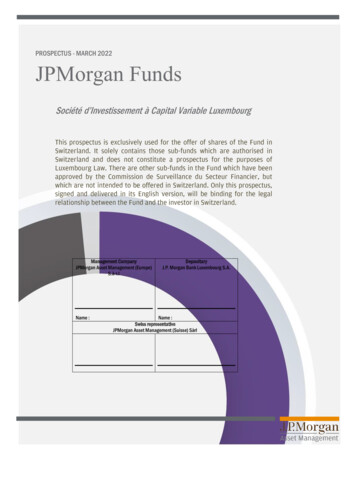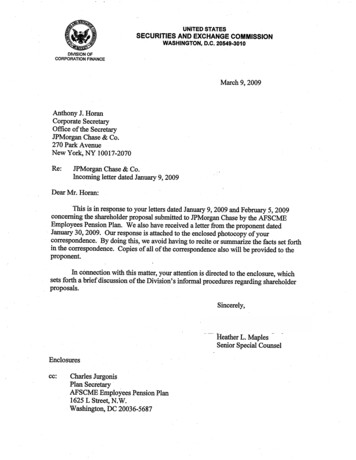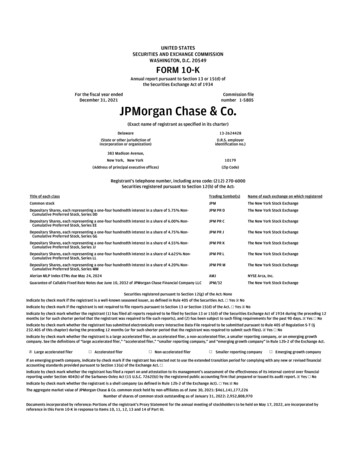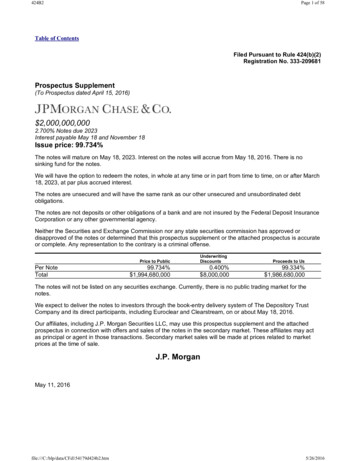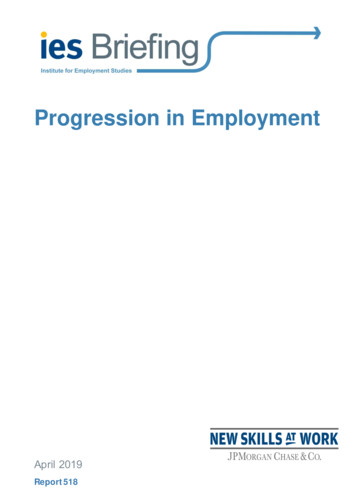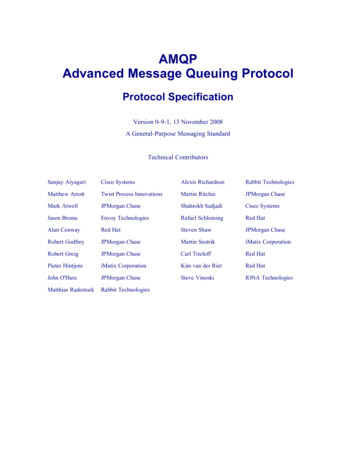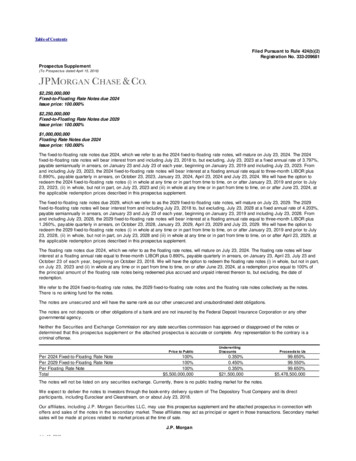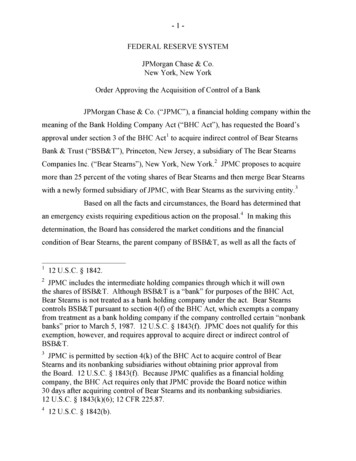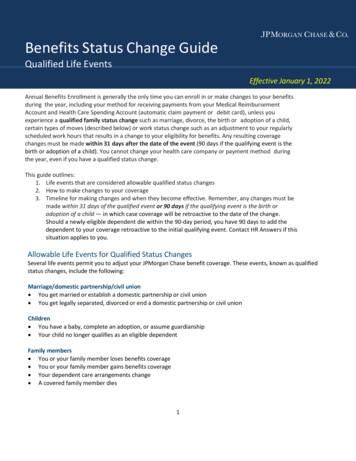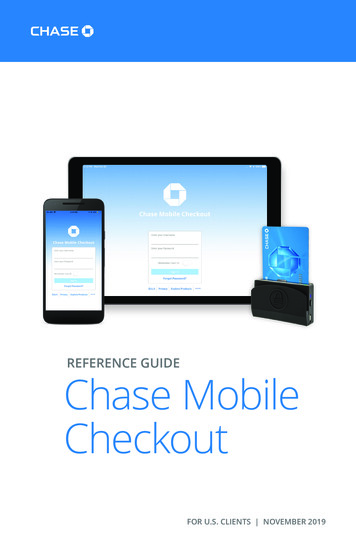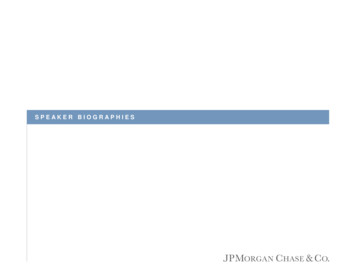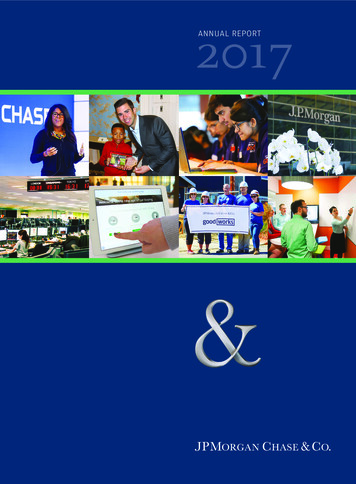
Transcription
2017ANNUAL REPORT
Financial HighlightsAs of or for the year ended December 31,(in millions, except per share, ratio data and headcount)2017 2016 2015Reported basis(a)Total net revenue Total noninterest expensePre-provision profitProvision for credit lossesNet income 99,624 95,668 93,54358,434 55,771 59,01441,190 39,897 34,5295,290 5,361 3,82724,441 24,733 24,442Per common share dataNet income per share:Basic DilutedCash dividends declaredBook valueTangible book value (TBVPS)(b)6.35 6.24 6.056.31 6.19 6.002.12 1.88 1.7267.04 64.06 60.4653.56 51.44 48.13Selected ratiosReturn on common equityReturn on tangible common equity (ROTCE)(b)Common equity Tier 1 capital ratio(c)Tier 1 capital ratio(c)Total capital ratio(c)10%10%11%12131312.1 12.2 11.613.813.9(d) 13.315.7 15.2 14.7Selected balance sheet data (period-end)Loans 930,697 894,765 837,299Total assets2,533,600 2,490,972 2,351,698Deposits1,443,982 1,375,176 1,279,715Common stockholders’ equity229,625 228,122 221,505Total stockholders’ equity 255,693 254,190 247,573Market dataClosing share priceMarket capitalizationCommon shares at period-end 106.94 86.29 66.03366,301 307,295 241,8993,425.3 3,561.2 3,663.5Headcount252,539 243,355 234,598(a) Results are presented in accordance with accounting principles generally accepted in the United States of America, except whereotherwise noted.(b) TBVPS and ROTCE are each non-GAAP financial measures. For further discussion of these measures, see Explanation andReconciliation of the Firm’s Use of Non-GAAP Financial Measures and Key Financial Performance Measures on pages 52–54.(c) The ratios presented are calculated under the Basel III Advanced Fully Phased-In Approach, and they are key regulatory capitalmeasures. For further discussion, see “Capital Risk Management” on pages 82-91.(d) The prior period ratio has been revised to conform with the current period presentation.JPMorgan Chase & Co. (NYSE: JPM) is a leading global financial services firm with assetsof 2.5 trillion and operations worldwide. The firm is a leader in investment banking,financial services for consumers and small businesses, commercial banking, financialtransaction processing, and asset management. A component of the Dow Jones IndustrialAverage, JPMorgan Chase & Co. serves millions of customers in the United States andmany of the world’s most prominent corporate, institutional and government clientsunder its J.P. Morgan and Chase brands.Information about J.P. Morgan’s capabilities can be found at jpmorgan.com and aboutChase’s capabilities at chase.com. Information about JPMorgan Chase & Co. is availableat jpmorganchase.com.
46.7 900 1.75 20046.7 million digital customersmake us the #1 most visitedbank website with the mostmobile banking customers 900 billion in debitand credit card salesvolume 1.75 billion inphilanthropic investmentsover the next five years 200 billion in cleanenergy financingby 2025TOPEMPLOYER#1400100%Named a top company byLinkedIn for where peoplewant to work#1 on Fortune’sChange the World listOpening 400 new branchesin 15-20 markets over thenext five yearsRenewable energy for100% of the firm’s globalpower by 2020 5 1.3 5 trillion daily valueof wholesale paymentsacross 120 currencies 1.3 trillion in assets undermanagement shifted toJ.P. Morgan by BlackRock aspart of the largest custodymandate in historyMILLION DIGITAL CUSTOMERSTRILLIONBILLIONTRILLIONBILLIONTOP50Top 50 metro areas coveredby Commercial Bankingfollowing expansion intonew locationsBILLION86%86% of long-term mutualfund assets undermanagement ranked intop two quartiles over10-year period
Dear Fellow Shareholders,Jamie Dimon,Chairman andChief Executive OfficerOnce again, I begin this letter with a sense of pride about JPMorgan Chase. As Ilook back on last year — in fact, the last decade — it is remarkable how well ourcompany has performed. And I’m not only talking about our strong financialperformance — but also about how much we have accomplished to help our clients,customers and communities all around the world. Ours is an exceptional companywith an extraordinary heritage and a promising future.We continue to make excellent progress around technology, risk and controls,innovation, diversity and reduced bureaucracy. We’ve helped communities largeand small — by doing what we do best (lending, investing and serving our clients);by creatively expanding certain flagship Corporate Responsibility programs,including the Entrepreneurs of Color Fund, The Fellowship Initiative and our ServiceCorps; and by applying our successful Detroit investment model to neighborhoodrevitalization efforts in the Bronx in New York City, Chicago and Washington, D.C.Throughout a period of profound political and economic change around the world,our company has been steadfast in our dedication to the clients, communities andcountries we serve while earning a fair return for our shareholders.2
12017 was another record year across many measures for our company as we addedclients and customers and delivered record earnings per share. We earned 24.4billion in net income on revenue1 of 103.6 billion (if we exclude the tax chargeat year-end, 2017 net income would have been a record 26.9 billion), reflectingstrong underlying performance across our businesses. We now have deliveredrecord results in seven of the last eight years, and we have confidence that we willcontinue to deliver in the future.RepresentsmanagedrevenueEarnings, Diluted Earnings per Share and Return on Tangible Common Equity2004–2017( in billions, except per share and ratio data)24% 19.0 17.4 15.415% 14.410% 11.7 8.5 4.00 4.336%15%15% 5.19 4.48 6.00 6.00 6.19 6.19 24.4Reported net income 17.911%13% 5.29 6.99 6.3113%13%12%20152016201713.6% Adjusted ROTCE1 4.34 5.6 2.35 4.5 1.522004 3.9610%15% 24.7Adjusted net income1 21.7 21.322% 24.4 26.9 2.26 1.352005200620072008200920102011201220132014Net income Diluted earnings per share Return on tangible common equity (ROTCE)1Adjusted results exclude a 2.4 billion decrease to net income as a result of the enactment of the Tax Cuts and Jobs Act (TCJA)Tangible Book Value and Average Stock Price per Share2004–2017High: 108.46Low: 81.64 58.17 38.70 43.93 36.07 47.75 35.492005 40.36 39.36 39.222006Tangible book value 21.96 22.5220072008 27.092009 30.122010 33.622011 38.68 40.7220122013 63.83 65.62 39.83 18.88 15.35 16.452004 51.88 92.01 44.602014 48.132015 51.44 53.5620162017Average stock price3
As you know, we believe tangible book value per share is a good measure of thevalue we have created for our shareholders. If our asset and liability values areappropriate — and we believe they are — and if we can continue to deploy thiscapital profitably, we now think that it can earn approximately 17% return ontangible equity for the foreseeable future. Then, in our view, our company shouldultimately be worth considerably more than tangible book value. The chart on thebottom of page 3 shows that tangible book value “anchors” the stock price.Bank One/JPMorgan Chase & Co. tangible book value per share performance vs. S&P 500Bank One(A)S&P 500(B)Relative Results(A) — (B)Performance since becoming CEO of Bank One(3/27/2000—12/31/2017)1Compounded annual gain11.8%5.2%6.6%566.3%147.3%419.0%JPMorgan Chase & Co.(A)S&P 500(B)Relative Results(A) — (B)Overall gainPerformance since the Bank Oneand JPMorgan Chase & Co. merger(7/1/2004—12/31/2017)Compounded annual gainOverall gain12.7%8.8%3.9%403.5%210.4%193.1%Tangible book value over time captures the company’s use of capital, balance sheet and profitability. In this chart, we are looking atheritage Bank One shareholders and JPMorgan Chase & Co. shareholders. The chart shows the increase in tangible book value per share;it is an after-tax number assuming all dividends were retained vs. the Standard & Poor’s 500 Index (S&P 500), which is a pre-tax numberwith dividends reinvested.1On March 27, 2000, Jamie Dimon was hired as CEO of Bank One.In the last five years, we have bought back nearly 40 billion in stock. In prioryears, I explained why buying back our stock at tangible book value per share wasa no-brainer. Six years ago, we offered an example of this, with earnings per shareand tangible book value per share being substantially higher than they otherwisewould have been just four years later. While we prefer buying back our stock attangible book value, we think it makes sense to do so even at or above two timestangible book value for reasons similar to those we’ve expressed in the past. If webuy back a big block of stock this year, we would expect (using analyst earningsestimates for the next five years) earnings per share in five years to be 2% —3%higher and tangible book value to be virtually unchanged.4
We want to remind our shareholders that we much prefer to use our capital to growthan to buy back stock. Buying back stock should only be considered when we eithercannot invest (sometimes that’s a function of regulatory policies) or when we aregenerating excess, unusable capital. We currently have excess capital, but due torecent tax reform and a more constructive regulatory environment, we hope, in thefuture, to use more of our excess capital to grow our businesses, expand into newmarkets and support our employees.Stock total return analysisBank OneS&P 500S&P Financials Index12.4%691.5%5.2%147.3%4.1%102.8%JPMorgan Chase & Co.S&P 500S&P Financials 21.8%15.8%8.5%22.1%18.2%3.7%Performance since becoming CEO of Bank One(3/27/2000—12/31/2017)1Compounded annual gainOverall gainPerformance since the Bank Oneand JPMorgan Chase & Co. merger(7/1/2004—12/31/2017)Compounded annual gainOverall gainPerformance for the period endedDecember 31, 2017Compounded annual gainOne yearFive yearsTen yearsThese charts show actual returns of the stock, with dividends reinvested, for heritage shareholders of Bank One and JPMorgan Chase & Co.vs. the Standard & Poor’s 500 Index (S&P 500) and the Standard & Poor’s Financials Index (S&P Financials Index).1On March 27, 2000, Jamie Dimon was hired as CEO of Bank One.Our stock price is a measure of the progress we have made over the years. Thisprogress is a function of continually making important investments, in goodtimes and not-so-good times, to build our capabilities — people, systems andproducts. These investments drive the future prospects of our company andposition it to grow and prosper for decades. Whether looking back over fiveyears, 10 years or since the Bank One/JPMorgan Chase merger (approximately 13years ago), our stock has significantly outperformed the Standard & Poor’s 500Index (S&P 500) and the S&P Financials Index. And this growth came during atime of unprecedented challenges for banks — both the Great Recession and the5
extraordinarily difficult legal, regulatory and political environment that followed.We have long contended that these factors explained why bank stock price/earnings ratios were appropriately depressed. And we believe the anticipatedreversal of many negatives and an increasingly more favorable businessenvironment, coupled with our sustained, strong business results, are among thereasons our stock price has done so well this past year.We do not worry about the stock price in the short run, and we do not worry aboutquarterly earnings. Our mindset is that we consistently build the company — ifyou do the right things, the stock price will take care of itself. In the next section,I discuss in more detail how we think about building shareholder value for the longrun while also taking care of customers, employees and communities.JPMorgan Chase stock is owned by large institutions, pension plans, mutual fundsand directly by individual investors. However, it is important to remember thatin almost all cases, the ultimate owner is an individual. Well over 100 millionpeople in the United States own stocks, and a large percentage of them, in oneway or another, own JPMorgan Chase stock. Many of these people are veterans,teachers, police officers, firefighters, retirees, or those saving for a home, schoolor retirement. Your management team goes to work every day recognizing theenormous responsibility that we have to perform for our shareholders.In this letter, I discuss the issues highlighted below — which describe many of oursuccesses and opportunities, as well as our challenges and responses.6
I.JPMorgan Chase Business StrategiesPage 81.How has the company grown?Page 82.How will the company continue to grow? What are the organic growthopportunities?Page 103.Why is organic growth a better way to grow — and why is it sometimes difficult?Page 124.Is there a conflict between building shareholder value vs. serving customers,taking care of employees and lifting up communities?Page 13Transparency, financial discipline and a fortress balance sheet. Why is thisdiscipline so important?Page 186.What risks worry us the most? And what could go wrong?Page 217.How is the company dealing with bureaucracy and complacency that ofteninfect large companies?Page 26What are the firm’s views on succession?Page 285.8.II. Public PolicyPage 291.What has gone wrong in public policy?Page 302.Poor public policy — how has this happened?Page 323.We can fix this problem through intelligent, thoughtful, analytical andcomprehensive policy.Page 334.The need for solutions through collaborative, competent government.Page 345.A competitive business tax system is a key pillar of a growth strategy.Page 356.We should reform and expand the Earned Income Tax Credit and investin the workforce of the future.Page 377.America’s growing fiscal deficit and fixing our entitlement programs.Page 398.Why is smart regulation vs. just more regulation so important?Page 419.Public company corporate governance — how would you change it? Andthe case against earnings guidance.Page 4310. Global engagement, trade and immigration — America’s role in the worldis critical.Page 447
I. J P M ORG AN CHA S E BUS IN ESS ST R AT EGI E SSince our business leaders describe their businesses later in this report, I am not going to berepetitive within this section. I encourage you to read their letters following this Letter toShareholders. Instead, in this section, I deal with some critical themes around how we runthis company – in good times and in bad times – and how we are continuing to build forwhat we think will be a bright future.1. How has the company grown?Below is a powerful representation of howwe have grown and built client franchisesover time.You can see from the numbers circled withinthe chart below that we have grown ourmarket share fairly substantially in most ofour businesses. In some cases, these marketClient Franchises Built Over the Long Term200620163.6%8.3%8.7%11 (25)8%NM15.9% 6613,079 805.1%14 (38)10%16%21.5% 1,0635,258 2358.5%16 (40)9%13%22.4% 1,1925,130 2738.7%Global Investment Banking fees4Market share4Total Markets revenue5Market share5FICC5Market share5Equities5Market share5Assets under custody (AUC)( T)#28.7%#86.3%#77.0%#85.0% 13.9#17.9%#111.2%#111.7%#210.1% 20.5#18.1%#111.0%#111.4%co–#110.3% 23.5CommercialBanking# of top 50 MSAs with dedicated teamsBankersNew relationships (gross)Gross Investment Banking revenue ( B)Average loans ( B)Average deposits ( B)Multifamily lending7261,203NA 0.7 53.6 73.6#28471,642911 2.3 179.4 174.4#1501,7661,062 2.3 198.1 177.0#1 Top 3 in overall Middle Market, large Middle Marketand Asset Based Lending Bookrunner21 Industry-leading credit performance — 6th straightyear of net recoveries or single digit NCO rateAsset & WealthManagementMutual funds with a 4/5 star rating8Ranking of long-term client asset flows9Active AUM market share10North America Private Bank (Euromoney)Client assets ( T)Client assets market share11Average loans ( B)# of Wealth Management client advisors119NA1.8%#1 1.33% 26.51,506220#22.5%#1 2.54% 112.92,504235#22.4%#1 2.84% 123.52,605 86% of 10-year long-term mutual fund assets undermanagement (AUM) in top 2 quartiles22 #2 in 5-year cumulative long-term client asset flowsamong publicly traded peers #1 Private Bank in N.A. and LatAm23 Revenue and long-term AUM growth 90% since 2006Deposits market share# of top 50 Chase marketswhere we are #1 (top 3)Average deposits growth rateActive mobile customers growth rateCredit card sales market share2Merchant processing volume3 ( B)# of branchesClient investment assets ( B)Business Banking primary market share241Consumer &CommunityBankingCorporate &InvestmentBank2017 Relationships with 50% of U.S. households I ndustry-leading deposit growth12 #1 U.S. credit card issuer13 #1 U.S. co-brand credit card issuer14 #1 U.S. credit and debit payments volume15 #2 merchant acquirer16 80% of Fortune 500 companies do business with us #1 in both N.A. and EMEA Investment Banking fees17 #1 in Global Long-Term Debt and Loan Syndications17 #1 in FICC productivity18 Top 3 Custodian globally with AUC of 23.5T19 #1 in USD payment volumes with 20% share in 201720 In Total Markets, J.P. Morgan has ranked #1 in eachyear since 201225 Equities and Prime are now ranked co-#125 J.P. Morgan Research ranked as the #1 GlobalResearch Firm26For information on footnotes 1–23, refer to slides 105-106 in the 2018 JPMorgan Chase Strategic Update presentation, which is available on JPMorgan Chase & Co.’s vestor-relations/document/3cea4108 strategic update.pdf), under the heading Investor Relations, Events & Presentations,JPMorgan Chase 2018 Investor Day, and on Form 8-K as furnished to the U.S. Securities and Exchange Commission (SEC) on February 27, 2018, which is available on the SEC’swebsite (www.sec.gov).24Source: Barlow Research Associates, Primary Bank Market Share Database as of 4Q17. Rolling eight quarter average of small businesses with revenues of 100,000 – 25 million25Source: Preliminary Coalition Global Industry Revenue Pool based on internal business structure, 201726Source: Institutional Investor magazine survey of large investors, 2017NM Not meaningfulNA Not availableFICC Fixed Income, Currencies and CommoditiesN.A. North America8EMEA Europe/Middle East/AfricaMSAs Metropolitan Statistical AreasLatAm Latin America/CaribbeanB BillionsT Trillions
I. JPMORG AN CHAS E BUS INESS STRATEGIESshare increases were due to our acquisitionsof Bear Stearns and Washington Mutual. Butin all cases, this growth is driven by consistent and disciplined investment in our businesses. The chart below shows how we tryto measure customer satisfaction in multipleways. For the most part, we have seen a risein these scores as well. It is a given that youwill not grow your share – unless you aresatisfying your customers – and we knowthey can always walk across the street to beserved by another bank.Increasing Customer SatisfactionU.S. retail banking satisfaction1ChaseIndustry averageBig banks2 Regional banks Midsized banks2011201220132014201520162017Source: J.D. Power U.S. Retail Banking Satisfaction Study, 20172Big banks defined as top six U.S. banks1Other important metricsIncreasing market share is a sign of increasing customer satisfactionConsumer & Community Banking Chase continues to lead the big banks and the industry average in U.S. Consumer Bank Customer Satisfaction studies includingbeing ranked #1 in retail banking advice in the U.S. and ranked #2 in the first ever National Bank study1 Customer satisfaction, measured by Net Promoter Scores (“NPS”), has continued to increase across most of our businessessince we brought CCB together five years ago. NPS increased year over year in Merchant Services, Business Banking, HomeLending, and Auto Digitally-engaged customers who bank with Chase are more satisfied than all other households, with higher NPS ( 19%),higher retention rates ( 10 percentage points), and higher card spend ( 118%) Digitally-engaged established customers who use Chase as their primary bank also have 40% more deposits and investmentswith usCorporate & Investment Bank Highest ever client satisfaction and retention levels for Custody & Fund ServicesCommercial Banking NPS for Commercial Banking Middle Market clients increased from 35 to 45 from 2011 to 20172 #1 in overall satisfaction, perceived satisfaction, customer relationships and transactions/payments processing3Asset & Wealth Management J.P. Morgan has ranked as the #1 private bank in the U.S. for nine consecutive years and #1 in Latin America for fiveconsecutive years4 J.P. Morgan has ranked as the Leading Pan-European Fund Management Firm for eight consecutive years51Source: J.D. Power 2018 U.S. Retail Banking Advice Study & 2017 National Bank Satisfaction StudySource: Greenwich Associates Commercial Banking Study, 2017Source: CFO magazine's Commercial Banking Survey, 20174Source: Euromoney, 20185Source: Thomson Reuters, 2017239
I. JPMOR GA N CH A SE BU S I N ESS ST R AT EG I ES2. How will the company continue to grow? What are the organic growth opportunities?We have good market share in most businesses, but we see organic growth opportunities almost everywhere – some large andsome small. Following are a few examples:Consumer & Community Banking We recently announced that we will startto expand the consumer branch businessinto cities like Boston, Philadelphia andWashington, D.C. Over the next five years,we hope to expand to another 15-20 newmarkets. We know the competition istough, but we have much to offer. WhenJPMorgan Chase comes to town, we comenot just with our consumer branches butalso with mortgages, investments, creditcards, private banking, small and midsizedbusiness banking, government businessand corporate responsibility initiatives tosupport our communities. In addition, this year we are rolling outmany new exciting products and havemade several improvements around thecustomer’s experience, including a fullymobile bank pilot (Finn), digital accountopenings, facial recognition in our app,the Amazon Prime Rewards Visa card anda simpler online application for BusinessBanking customers. We also are adding many tools that willhelp our customers manage their financialaffairs. For example, in the credit card business, we will be allowing our customersto review and decide how and where theywant their cards and credit lines to be used.In Consumer Banking, we are adding financial planning tools and insights that helpcustomers make the most of their money –and there’s more coming.Corporate & Investment Bank We see growth opportunities even inFixed Income, Currencies and Commodities, where we already have the #1 marketshare at 11.4%. There may be some underlying growth as the capital markets of theworld grow, even though this is partiallyoffset by declining margins like wehave experienced over the last 30 years.However, we see opportunities to gainshare in various products and in certainregions where we have low share. This opportunity would be true for Investment Banking, too. Country by countryand industry by industry, there are stillplenty of opportunities to increase our lowmarket share. For example, we have 10%share in the United States but less than5% share in Asia. In Treasury Services and Custody, whereour market shares are 4.7% and 8.0%,respectively, we believe we can growsignificantly by adding bankers, buildingbetter technology, entering new countries,building better products and continuing todo a great job for clients. In this business,while you make large initial investmentsin order to grow, when you gain clients,they usually stick with you for a long time. Over time, we do expect to expand ourCorporate & Investment Bank into newcountries, which will benefit all the businesses within this franchise.Commercial Banking This past year, Commercial Banking hascompleted its expansion into the top 50markets in the United States – this willdrive growth for decades. And remember,when Commercial Banking opens itsdoors, it also helps drive the growth ofour Private Bank and the Corporate &Investment Bank businesses. Commercial Banking has added manyspecialized industry bankers to betterserve those specific segments.10
I. JPMORG AN CHAS E BUS INESS STRATEGIESAsset & Wealth Management In the United States, our share of theultra-high-net-worth market ( 10 millionor greater) is 8%. We believe we have asuperior business and that we can growour share by essentially adding bankers,branches and better products. In the high-net-worth business ( 3 millionto 10 million) and the Chase affluentbusiness ( 500,000 to 5 million), ourmarket shares are only 1% and 4%, respectively. We have no doubt that we can growby adding bankers and locations, particularly because we have some exciting newproducts coming soon. There is no reasonwe can’t more than double our share overthe next 10 years. We are also adding new products, likeindex funds and exchange-traded funds(ETF), that we believe will help drivegrowth.Across the companyIn addition, we are undertaking manyinitiatives across the company that will helpgrow our businesses and better serve ourcustomers. On the payments front, we have developed multiple products to make wholesalepayments better, easier and faster. Weare rolling out these products across ourplatforms, and they should help us solidifyand grow our position. On the consumer side, we have introduced Chase Pay, the digital equivalentto using a debit or credit card, whichallows customers to pay online or in-storewith their mobile phone. We also introduced Zelle, a real-time consumer-toconsumer payments system, whichallows customers to easily, safely andimmediately send money to their friendsand family. We expect these productsto drive lots of customer interactionsand make our payments offeringscompelling, even as some very smartfintech competitors emerge. Across the company – not just in technology – we have thousands of employeeswho are data scientists or have advanceddegrees in science, technology, engineering and math. Of the nearly 50,000people in technology at the company,more than 31,000 are in development andengineering jobs, and more than 2,500are in digital technology. Think of thesetalented individuals as driving changeacross the company. Artificial intelligence, big data and machinelearning are helping us reduce risk andfraud, upgrade service, improve underwriting and enhance marketing across thefirm. And this is just the beginning. Our shared technology infrastructure– our networks, data centers, and thepublic and private cloud – decreases costs,enhances efficiency and makes all ourbusinesses more productive. In addition,this allows us to embrace the fact thatevery business and merchant has its ownsoftware and also wants easy, integratedaccess to our products and services. Weare delivering on that through the creationof a common JPMorgan Chase API (application programming interface) store thatallows customers to add simple, securepayments to their software. And we arebuilding everything digital – both for individual customers and large corporations –from onboarding to idea generation. Increasingly, the management teamsof Consumer & Community Banking,Corporate & Investment Bank,Commercial Banking and Asset & WealthManagement share ideas, share platformsand serve each other’s customers. Thesuccess of any one business almost alwayshelps the other three.11
I. JPMOR GA N CH A SE BU S I N ESS ST R AT EG I ES Privacy and safety – we spend an enormous amount of resources to protectall of our clients and customers fromfraud, cybersecurity risk and invasionof their privacy. These capabilities areextraordinary, and we will continue torelentlessly build them. As part of this, wehave consistently warned our customersabout privacy issues, which will becomeincreasingly critical for all industriesas consumers realize the severity ofthe problem. Last year, we wrote abouta new arrangement with Intuit thatbears repeating – it briefly describedthe problem and presented a solution,which we hope might set a standard forprotecting customers while giving themcontrol of their data.For years, we have been describing therisks – to banks and customers – that arisewhen customers freely give away theirbank passcodes to third-party services,allowing virtually unlimited access totheir data. Customers often do not knowthe liability this may create for them iftheir passcode is misused, and, in manycases, they do not realize how their dataare being used. For example, access tothe data may continue for years aftercustomers have stopped using the thirdparty services.We recently completed a newarrangement with Intuit, which we thinkrepresents an important step forward.In addition to protecting the bank, thecustomers and even the third party (inthis case, Intuit), it allows customers toshare data – how and when they want.Under this arrangement, customers canchoose whatever they would like to shareand opt to turn these selections on or offas they see fit. The data will be “pushed”to Intuit, eliminating the need for sharingbank passcodes, which protects the bankand our customers and reduces potentialliabilities on Intuit’s part as well. We arehoping this sets a new standard for datasharing relationships.Events from the past year underscore theimportance of efforts like this. As questionsare raised about how consumers’ information is shared and protected, I stronglybelieve that data privacy and security shouldbe a way in which we and other businessescompete to serve customers.3. Why is organic growth a better way to grow — and why is it sometimes difficult?Organic growth is all about hiring andtraining bankers, opening branches,improving or innovating new products andbuilding new technology. It is hard work.In fact, institutionally, there is often a lotof resistance to it. It’s easier not to addexpenses, even when they are good for t
and JPMorgan Chase & Co. merger (7/1/2004—12/31/2017) Compounded annual gain 12.7% 8.8% 3.9% Overall gain 403.5% 210.4% 193.1% Tangible book value over time captures the company's use of capital, balance sheet and profitability. In this chart, we are looking at heritage Bank One shareholders and JPMorgan Chase & Co. shareholders.
